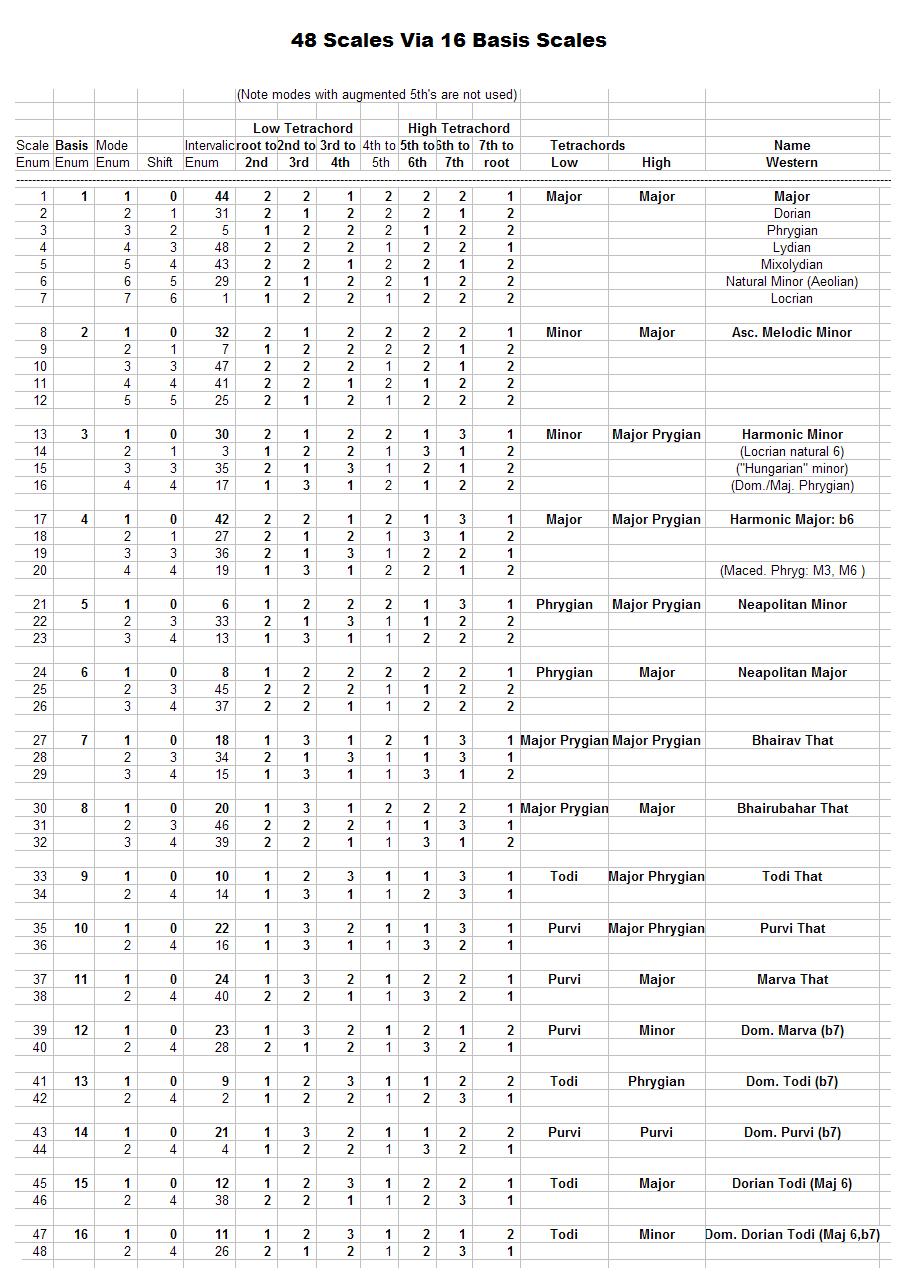
© 2012 Kevin Ferguson/Debone Music
Here's a strategy to quickly master all 7 note scales which have 7 unique scale degrees. These cover the western classical modal scales (based on tempered scales) as well as the 10 classical Hindustani that's (based on pure harmonics), a large set of important components of the Turkish, Arabic and related Maqam, and many others. And even mores scales, including blues scales, correspond to extended modes some of of these 48 scales.
I derived the 16 Basis Scales in 2006 using concepts of basis vectors for transforms applied to the 48 heptatonic scales. I've been using these and their modes, which span the 48 scales since then in performances and my recordings of hundreds of world music, original music and, especially lately, improvised music. As of 2012, I perform regularly with Playback Theater, an improve theater group that listens to audience member stories and plays them back on the spot as improvised performances accompanied by music I improvise. Having a wealth of scales and the theory behind them at your finger tips comes in handy for this.
The approach I'm taking here is to take small intervallic building blocks to build a set of basis scales, of which modes span a complete set of scales. That is, we'll use 4 note interval building blocks, 4 on the bottom and 4 on the top for 8 notes covering 1 octave, to construct 16 unique scales. Modes of a scale correspond to moving the tonic from the first note in the scale to the second, third, forth, fifth, sixth or seventh. Using modes of the 16 basis scales, we can create the 48 scales. All of this is done using relative intervals such that transposing each of the 48 scales across the chromatic scale gives us 576 scales to work from. And even mores scales, including blues scales, correspond to extended modes some of of these 48 scales. But wait, there's more: using concepts from Maqam and other music paradigms, scales can be constructed that change from octave to octave, so that an extremely large number of scales can be created....But let's start with looking at 4 notes at a time, or more specifically 3 relative intervals of 4 notes.
-----------------------------------------------------------------------------------------------------
6 Basis Tetra-chords
-----------------------------------------------------------------------------------------------------
| Intervals
Name |--------------------------------------------------------------------------------
| Steps Type of 2nd Number of chromatic steps
-----------------------------------------------------------------------------------------------------
Minor | 1, 0.5, 1: major, minor, major: 2 1 2
Major | 1, 1, 0.5: major, major, minor: 2 2 1
Phrygian | 0.5, 1, 1: minor, major, major: 1 2 2
Major Phrygian | 0.5, 1.5, 0.5: minor, augmented, minor: 1 3 1
Todi | 0.5, 1, 1.5: minor, major, augmented: 1 2 3
Purvi (Major Todi)| 0.5, 1.5, 1: minor, augmented, major: 1 3 2
----------------------------------------------------------------------------- 16 Basis Scales ----------------------------------------------------------------------------- Basis Lower Upper Example using C as Scale Tetrachord Tetrachord the tonic ----------------------------------------------------------------------------- Major Major Major C D E F G A B C Ascending Melodic Minor Minor Major C D Eb F G A B C Harmonic Minor Minor Major Phrygian C D Eb F G Ab B C Harmonic Major Major Major Phrygian C D E F G Ab B C Neapolitan Minor Phrygian Major Phrygian C Db Eb F G Ab B C Neapolitan Major Phrygian Major C Db Eb F G A B C Bhairav Major Phrygian Major Phrygian C Db E F G Ab B C Bhairubahar Major Phrygian Major C Db E F G A B C Todi Todi Major Phrygian C Db Eb F# G Ab B C Purvi Purvi Major Phrygian C Db E F# G Ab B C Marva Purvi Major C Db E F# G A B C Dominant Todi Todi Phrygian C Db Eb F# G Ab Bb C Dominant Purvi Purvi Phrygian C Db E F# G Ab Bb C Dominant Marva Purvi Minor C Db E F# G A Bb C Minor Marva Todi Major C Db Eb F# G A B C Minor Dominant Marva Todi Minor C Db Eb F# G A Bb C
The table below shows the 48 scales as modes (indicated by the "Shift" column which corresponds to how many scale degrees to skip to find the tonic of the mode vs. the basis scale).

So, using the 6 sets of 3 intervals to form tetrachords from which to form the 16 basis scales, which in turn form the 48 scales, which can each be played using 12 tonics (on western instruments), and further modified based on scale direction, degree, octave and the location in the progression of the melody, one can has a nearly infinite set of melodic possibilities from which to choose.
Kevin Ferguson is a Portland, Oregon based guitarist, engineer, scientist, inventor with several albums and dozens of patents. See his homepage for more articles on music, including how to master complex rhythms and example audio and video recordings of his performances of these using many of the scales described above, along with music videos, inventions and more.